VOL. 28, #4, Winter 2010
Burma Ruby Sells For $2.9 Million, Burmese Embargo, Auction Reports, Jessica Simpson's Burma Ruby, Victoria's Secret $2 Million Bra, Gem Heists, In The News
- Home
- Newsletter
- VOL. 28, #4, Winter 2010
Burma Ruby Sells For $2.9 Million, Burmese Embargo, Auction Reports, Jessica Simpson's Burma Ruby, Victoria's Secret $2 Million Bra, Gem Heists, In The News
7.04 Burma Ruby Sells For $2.9 Million
by Robert G. Genis
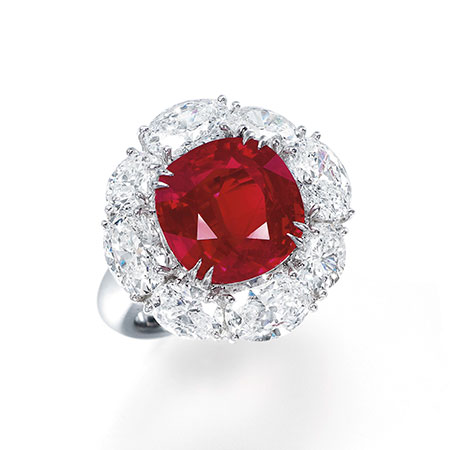
Although this per carat price is not a record, it fell short of the 8.62 that was sold for $3.62 million in 2006 at Christie's. That Burma ruby was purchased by Graff and the record remains $420,000 per carat. Perhaps the 7.04 would be a new world record if it were a carat larger?
Recent Large Burma Rubies At Auction:
Christie's 2005: An Asian private pays $2.2 million or $274,000 per carat for an 8.01 Burma ruby.
Christie's 2006: Graff pays $3.62 million or $420,000 per carat for an 8.62 Burma ruby.
Christie's 2006: Graff buys the 9.25 Burma ruby for $2.42 million or $ 261,000 per carat.
Christie's 2007: A 12.43 carat cushion Burma ruby sold for $2 million or $160,000 per carat to an Asian buyer.
Christie's 09: A 7.03 Burmese ruby sold for $1.13 million or $160,000 per carat to a private Asian buyer.
Sotheby's 2010: An 8.66 cushion-shaped Burmese ruby sold for $2,098,500 or $242,000 per carat.
Christie's 2010: An old 9.20 Burmese ruby sold for $3.3 million or $358,000 per carat.
What can we tell from these numbers?
First, it is hard to judge these various gemstones because not all have AGL grading reports. Other grading reports will tell us if the stone is Burma and if the stone is heated, but will not give us an idea regarding color/tone, clarity, cutting, brilliancy and finish. This makes pure comparisons difficult. However, we can usually tell from the pictures if the stones are red or not. Obviously, the redder stones sell for more per carat. For example , the 8.01 Burma ruby had an AGL report. We know it was only 65% red but free of inclusions. The bottom line is large unheated Burma rubies of top quality (we assume this or the buyers would not have spent this type of money) range from $160,000-$420,000 per carat.
Today's Prices and the Internet
As everyone knows, large unheated red Burma rubies are ultra rare. This has been true for decades. The amount the large goods from Burma seems to be played out. It doesn't matter what the political or economic situation is in Burma. Even today, when a large stone is found in Burma, the dealers ask auction-like prices for these goods. Even in Burma, dealers have access to the net and auction sites.
Conclusion
Although these gemstones have been flying under the radar compared to colored diamonds, these stones sell for far more than large D-IF diamonds. For example, large 20 carat D-IF's are selling in the $135,000 per carat range. We wonder when these stones will get to the eventual price of $1 million per carat? We expect sooner than later. We remember 1987, when the first colored diamond sold for almost $1 million per carat. The .95 Hancock red diamond actually sold for $926,000 per carat. Now it's routine for large colored diamonds to garner million per carat dollar bids. If you have any unheated Burma rubies, our advice is to hold on. These stones are irreplaceable.
Burmese Embargo
Where Aung San Suu Kyi, Myanmar's Nobel Prize Winner, Is Wrong
Forbes
by Shaun Rein
November 16, 2010
She's right about the desperate need for change, but doesn't understand how to achieve it.
Editor: We believe the Burmese ruby and jade embargo should be lifted. As we stated in 2008, embargos do not work. Instead,embargos enhance the power of the regime. This article is the most clear headed rebuttal we have seen lately.
Unlike many recent Nobel Peace Prize winners, Aung San Suu Kyi actually deserved it. She sacrificed her freedom to seek liberty for her countrymen against Myanmar's military junta. Who could be a better beacon for goodness? She is my hero. After being released from undeserved house arrest, she has preached reconciliation, but she is not backing down from her demands for democracy. I support her.
However, as much as I respect Suu Kyi (and I respect her a lot), I feel certain that she needs to go beyond reconciliation and rethink her strategy of pushing the Western world to implement stringent economic sanctions against Myanmar. She should be promoting active economic engagement instead.
Economic sanctions do not cause the downfall of unsavory regimes. They only further impoverish ordinary people who live in terror and hardship. In fact, sanctions bolster regimes, as they concentrate power more tightly among elite families, who become more insecure and heavy-handed in their attempts to annihilate opposition as they grow to fear for their lives. They starve common people while doling out benefits to a select few thugs.
Implementing economic sanctions is a naive strategy at best. It is a basic tenet of American diplomacy that Suu Kyi should shelve.
Case in point: North Korea. Several months ago I wrote that Hillary Clinton was misguided in moving to implement more sanctions against North Korea. I received lots of violent hate mail, and online message boards lit up. Most of the responses went something like, "You are an idiot. Hope you die a rotten death. Kim is bad."
Yet no one answered the question I posed: Name one instance where economic sanctions have worked. Just one. I repeat that question. We haven't overthrown Castro in Cuba or the leaders of Iran. They remain in power, driving Mercedes while poor people can't get medical supplies. Leaders will always be able to skirt sanctions to enrich themselves.
What have Clinton's actions in North Korea achieved? If anything, Kim Jong Il's power base is stronger now than before. The Chinese have forged closer relations with his regime to ensure stability in a border country and to buffer against America's increasing assertiveness in Asia. Since Clinton's pronouncements, pictures of Kim and his anointed heir, his son Kim Jong Un, have been displayed often in China's newspapers. Rival groups in North Korea have coalesced around Kim. The same will happen in Myanmar if the West pushes too hard.
What should Aung San Suu Kyi or her supporters do? She should press for greater economic engagement with the West and encourage reform within the system by working with the junta. That way improvements will come incrementally, but at least they will come. Partnering with your enemies, evil as they may be, can be hard, but it is what must be done.
Engagement with Myanmar has been Thailand's strategy. Thailand's foreign minister said recently that he supports democratization in Myanmar but that the process must go in stages, much as it did in Thailand over the last half century. His strategy is to give soft loans and education exchanges, and then push for private corporate investment.
That is the right course of action, and it has already been proven to work. Where? In China.
Since the Tiananmen Square incident in 1989, China has become the world's second-largest recipient of foreign direct investment, after U.S. companies like Nike (NKE), General Electric (GE) and Apple (AAPL) have invested billions there, with a palpable effect on the quality of life of ordinary Chinese.
Unless you are a fool or a knee-jerk ideologue, you can't argue that the quality of life of most Chinese isn't far better now than just a decade ago. In 2000 it was difficult for Chinese to move freely within the country. This year 52 million Chinese traveled abroad. They are the biggest per-capita foreign spenders in France.
Chinese can marry who they choose, and they have greater access to outside news sources than ever before. Millions have studied abroad. When I was a graduate student at Harvard, there were more mainland Chinese there than students from any other foreign country.
When I first moved to China, in the mid-1990s, the only readily available foreign reading was the heavily censored China Daily and classic books like he Hunchback of Notre Dame. Now nearly all Western media outlets are available online, even ones often critical of China, like The New York Times.
Active engagement and economic ties helped bring about China's reforms, and they continue to improve life for ordinary Chinese. Aung San Suu Kyi should learn from China's experience with reform. Active engagement is a proven model for bettering people's lives. Economic sanctions are a failed policy.
World Auction Winter Reports
Christie's Hong Kong December, 2010
The total sales for the auction were $79.9 million, the highest amount ever in Asia.
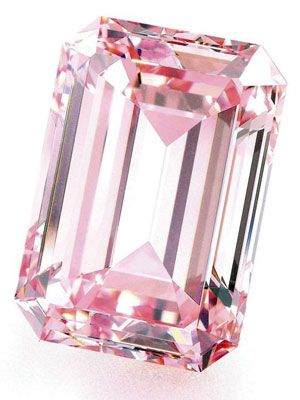
A 14.23 fancy Intense pink diamond was sold to an anonymous buyer for $23.2 million or over $1.6 million per carat. It was dubbed the "perfect pink" because of its color and clarity. The presale estimate was between $14 million and $19 million. This is a record for the most expensive gem ever sold in Asia. As a general rule, large pinks are light in color and small hot pinks are included.
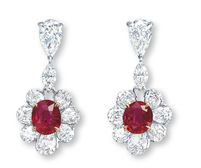
A pair of cushion Burma ruby earrings weighing 5.12 and 4.24 sold for $2.59 million or almost $280,000 per carat.
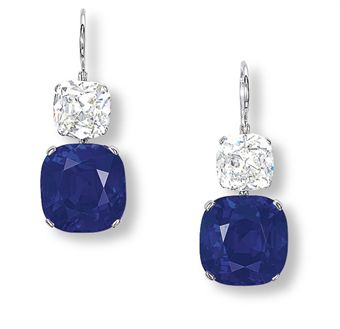
Christie's Geneva November 2010
Most of the major stones at this auction were white diamonds. The most interesting colored diamond was a rectangular 12.30 fancy intense orangy-pink, SI1 clarity, which sold for $1.45 million or $118,000 per carat.
Sotheby's Geneva November 2010
Sotheby's Magnificent Jewels sale was held in Geneva on November 17. The auction sale generated almost $105 million with 82 percent sold by lot.
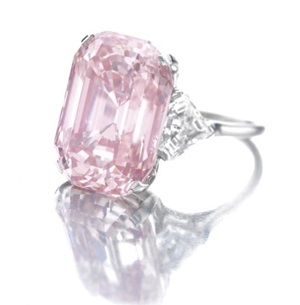
The key piece was the emerald shaped 24.78 Fancy Intense pink, VVS2 diamond. It was purchased by Graff for $46 million or over $1.8 million per carat. He competed with four other bidders and immediately renamed the stone The Graff Pink." The stone had originally been purchased from Harry Winston 60 years ago. It was the first time it had come back to the market.
A 4.59 pear-shaped fancy intense pink diamond ring sold for $2.8 million or slightly over $610,000 per carat.
Sotheby's New York December 2010
Sotheby's sale of Magnificent Jewels brought a total of slightly over $53 million, or 88% sold by lot.
The top price was a D-Flawless diamond, weighing 27.19 carats, which sold for over $3.6 million or $134,847 per carat. This is almost the exact same price as the the D-IF which sold last year at Sotheby's.
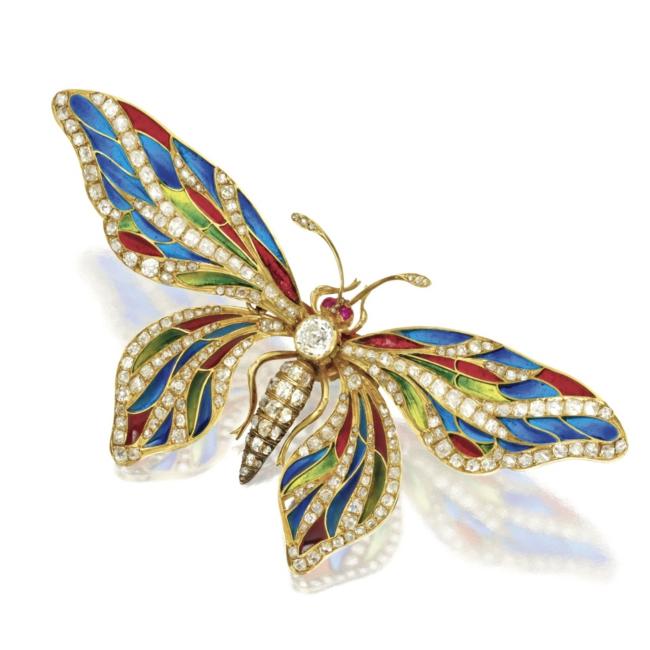 |
 |
One high point was the offering of magnificent jewels from the collection "Jewels from the Estate of William B. Deitrich". He was a collector extrodinaire of fine art, gems and jewelry. He amassed an eclectic collection based upon nature. The sale of the collection was over $4.2 million.
Some of the more interesting pieces were:
3.03 fancy pink diamond , VVS1, sold for $482,000.
Matching 1.31 fancy intense blue, I1 and 1.34 fancy light pink, IF diamonds for $242,500.
A pair of 18k gold, platinum ruby and diamond earrings from Van Cleef and Arpels, 1966 for $170,500.
7.44 Burma ruby, AGL graded, heated for $152,500.
3.30 vivid yellow-green diamond, VS2 for $140,500.
A 16.16 star purplish Burma ruby with weak leg for $110,500.
A 5.38 Brazilian alexandrite, AGL, color change excellent for $95,500.
A 4.25 Burmese ruby, AGL, no heat for $92,500.
A 6.00 star ruby for $68,500.
A 20 carat violet color change sapphire, AGL, color change very good to good for $62,500.
An enameled butterfly with diamonds and ruby eyes (one missing) originally from the estate of Jacqueline Kennedy Onassis for $62,500.
A .85 fancy light to fancy grayish blue with a .65 yellow sold for $53,125.
An enamel and diamond dragonfly for $46,875.
A .44 fancy vivid purplish pink for $37,500.
Christie's NY December, 2010
The sale brought in over $22 million.
The highlight of the show was a 6.89 fancy vivid purple-pink that sold for $1 million per carat. Also, 10.91 carat pear-shaped fancy intense pinkish orange natural color diamond garnered over $2.3 million. A 7.30 modified rectangular fancy purple-pink brought in $902,500. The presale estimate was $500,000 to $700,000.
The top colored stones were Kashmir sapphires. A 14.55 cushion cut Kashmir sapphire sold for $422,000. After the sale, a 37.57 Kashmir sapphire sold for or $542,500. Interestingly, a 48.57 Mozambique cushion ruby sold for $182,500 .
Christie's London December, 2010
The Portland collection, a rare collection of old gemstones were offered to the market for the first time. It sparked fierce competition between people from 26 countries. Many items went for 3x the presale estimates.
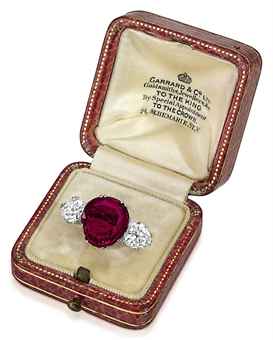
The top lot was a 9.20 Burmese ruby ring. It sold for $3.3 million or $358,000 per carat. According to Christie's, the flat shape and irregular outline of this ruby suggests that it may have been adapted by Duchess Winifred from a 17th century ancestral jewel.
Christie's NY October, 2010
The 10.95 Vivid Blue Bulgari Blue Diamond, featured in the Gemstone Forecaster's last edition, sold for US$15,762,500, or US$1.4 million per carat. This is a new world record price per carat for a blue diamond at auction. The stone had been purchased at Bulgari's in Rome in 1972 for US$1 million or $5 million in today's dollars. The bidding battle was between an European collector and an Asian collector. Bidding started at $8 million and rose in $500,000 increments. After five minutes, the Asian collector was the winner.
Jessica Simpson's Burma ruby
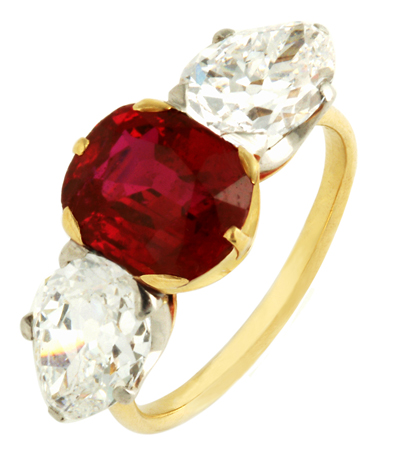
Some experts are saying the ring is a rare vintage piece from 1900. The stone is flanked by two matching "old European cut" pear shaped diamonds. Experts put the value of the piece at $100,000.
The photographs of the stone show the ruby is red. I tend to believe these photographs because they were taken by the press. I doubt they "photoshopped" the ruby or have the vaguest idea how to make the stone look better. One has to assume the stone is an old unheated Mogok Burma ruby. Of course, it is also possible the stone has been replaced in an old mounting with a heated, fracture-filled Mong Hsu Burma gem. That is the only way the piece could only be worth $100,000 retail. If in fact the stone is unheated and Burmese, the price is worth considerably more than the "experts" know.
Victoria's Secret Bra
Italian Jeweler Damiani designed a $2 million Bombshell Fantasy bra for Victoria's Secret for Christmas. The design took 1500 hours of labor to make. Brazilian supermodel Adriana Lima wore the 18k white gold undergarment with 3000 white (60 carats) diamonds, and 82 carats of light blue sapphires and topaz. The bra pattern was designed to produce a heavenly display of swirling stars and constellations.
The price of these bras has steadily declined over the past few years. The most expensive bra was $15 million in 2000. In 2005, the price was $12.5 million. For the past five years the prices have declined to today's $2 million bra.
The bra on the net at:
http://www.youtube.com/watch?v=TzjqM2bNXV4
Gem Heists
Businessman shot at Bogota airport
Colombia Reports
September 23, 2010
by Adriaan Alsema
A Colombian businessman was injured when assassins shot him in front of Bogota's international El Dorado airport on Wednesday evening, local media reported.
According to airport police commander Colonel Rafael Mendez, the victim had just arrived from Fort Lauderdale and was attacked when he, his wife and 7-year-old son were getting into the family car that was parked on the airport parking lot.
"They shot a few times and one bullet hit him in the chest. The gentleman is an emerald trader, had several bodyguards and was about to get into his car. He is stable and in the Colombia clinic," the police official told Caracol Radio.
Following the attack, the assassins got into a taxi and fled. The motorbike they had arrived on was left abandoned at the scene, Mendez said.
Bogota police are now looking for the taxi and the perpetrators of the attack, the police official added.
On the net Colombian Emerald slides: http://www.bbc.co.uk/news/world-latin-america-11669404
Police Hunt for $1M Stash of Stolen Jewelry
Israeli Diamond Blog
October 2010
by Roe Kalb
Every time a robbery happens it calls to mind an action film, with the good guys, the bad guys and of course a lot of money or a sexy piece of diamond jewelry. These days, Toronto police having arrested four suspects in a $1 million jewelry theft who are currently awaiting trial - are on the hunt for the stash itself, which includes a 5.1-carat diamond ring valued at $200,000.
Robbery
The saga, worthy of a Hollywood movie, began in early January when, police say, suspect David Compagnoni contacted the owner of a jewelry store on Queen Street West, asking to purchase a "three or four carat" diamond engagement ring.
Diamond Ring
A few days later, according to police, the store's owner advised Mr. Compagnoni that he had located a 5.16-carat diamond ring and arrangements were made for Mr. Compagnoni to stop by the store to see the ring.
On January 9, Mr. Compagnoni, along with fellow suspects Marco Cipollone and Andrew Gordon, visited the store to pick up the ring. Police say that the men intended to pay using counterfeit bank drafts a plan that went south when the jeweler told them he would have to check with the bank to make sure the drafts were genuine before handing over the ring.
Once the plan went south, police say, Mr. Gordon pulled a gun and threw the store owner to the ground. The noise alerted another business owner in the same building, who came over to investigate, only to find himself bound and gagged with duct tape along with the jeweler. The suspects absconded, taking not only the ring, but $600,000 worth of loose diamonds, earrings, and other jewelry.
Diamonds
Toronto Crime Stoppers Detective Darlene Ross told reporters that the robbery was a "somewhat well-planned criminal offense." Police arrested the three robbery suspects shortly after the incident, along with a fourth man, Antonio Bandiera, suspected who allegedly faked the bank drafts they intended to use to "pay" for the diamond ring. But law enforcement has yet to recover the jewelry, and have appealed to the public for help.
Det. Ross said that the diamond ring had a very unique cut, color, and clarity not to mention size, and was not the kind of jewelry even professionals would see on a daily basis. "We're appealing to all the honest reputable people in the jewelry business
you will know if you've seen this," she urged.
Toronto Police Detective Rob Lemaitre of the holdup squad said he was concerned that the ring's diamond could have been cut up and sold off as smaller stones, but because the diamond was unique police believe it is more likely that the ring has remained intact. According to Lemaitre, evidence suggests that additional people may have been involved in the heist.
Mr. Compagnoni, 41; Mr. Cipollone, 34; and Mr. Gordon, 34; and Bandiera, 35; all face a barrage of charges, including conspiracy to commit an indictable offense; robbery while armed with a firearm; forcible confinement and fraud over $5,000. A court date has not yet been scheduled.
Man on diamond diet nabbed
Times of India
October 28, 2010
A Sri Lankan who had 2,060 pieces of diamonds and other precious stones lodged in his stomach was arrested from the Chennai airport by the central crime branch of the suburban police. The stones, estimated to be worth between Rs 1.5 crore to Rs 3 crore, were recovered.
Addressing a press conference on Wednesday, Chennai suburban police commissioner S R Jangid said he received a call on Tuesday morning from a reliable informant that the man was travelling to Chennai on an Air India flight. "That was the only information available and no other clue, but we zeroed in on him as soon as he came out of the airport and tried to board a taxi,'' he said.
The Lankan, identified as Mohamed Rafi (35), who arrived from Colombo on Tuesday morning, had successfully cleared the customs and immigration. A team led by assistant commissioner of police S Jayakumar picked up Rafi who was carrying two hand bags, but the search of the bags proved futile.
Rafi was then confronted by the sleuths but he maintained that he was innocent. He was even warned that he would be subjected to medical test. The police commissioner said that even during questioning, Rafi could not sit comfortably and when questioned, he told the police that he was suffering from piles. The police, who grew suspicious, took him to Chromepet Government Hospital. When doctors examined him, they found the stones lodged in his gut.
Displaying the stones, Jangid said Rafi had a valid passport and was acting as a human courier and was paid only Rs 10,000 for the job. He had stored the precious stones in 42 condoms and had swallowed all of them. It took the police six hours to retrieve the stones after they fed him with laxatives and bananas.
Rafi is a native of Galle and had done three such runs to Chennai from Colombo in the past but his luck ran out during his fourth attempt. He told the police that he was to book into a lodge in Mannady and that someone was to come over to collect the stones. He told the police that on previous occasions, three persons named Kumar, Rafiq and Sabir had collected the consignments.
V Varadharaju, deputy commissioner of police, said Rafi had confessed to swallowing the stones at 4 am on Tuesday before boarding the 6.30 am flight from Colombo. He would be handed over to the customs who would probe his international links, police said.
In The News
Myanmar gem fair nets record $1.4 bln -govt official
Reuters
Dec 7, 2010
by Aung Hla Tun and Martin Petty
Gem traders in Myanmar, one of the world's biggest producers of precious stones, took in a record 1.08 billion euros ($1.44 billion) at a 13-day emporium last month, a government official said on Tuesday.
The fair in the capital, Naypyitaw, attracted some 6,700 traders, 4,000 of them from overseas, with 9,157 lots of jade, 273 lots of gems and 237 lots of pearls sold in auctions, said the official, who requested anonymity.
"These are the highest proceeds from a single sale of jade, gems and pearls since 1964," he told Reuters.
Gemstones are a lucrative source of income for Myanmar's military government, despite Western sanctions imposed on the resource-rich country, some of which outlaw the procurement and sale of Burmese stones.
Myanmar produces more than 90 percent of the world's rubies and fine-quality jade. Most of Myanmar's jade and gemstone mines are run by the defence and mines ministries and businessmen with close connections to the regime.
The United States Congress passed a bill in October 2007 to expand sanctions prohibiting the domestic sale of rubies, jade and other gems routed through Myanmar's neighbours. Experts say this has had only a limited impact on the junta because most buyers are from China, Hong Kong and Taiwan.
This is the first time in five years that the government has indicated how much money has been generated from the emporium, which is usually held in the biggest city, Yangon.
Officials said trade fairs held in March and October generated 400 million and 700 million euros respectively.
Myanmar recently launched a drive to attract foreign investment, particularly from Asian countries, to what it says is a market with vast potential held back by Western sanctions.
Many analysts believe the regime is trying to promote its natural resources, particularly energy, to attract foreign interest and force a review of trade embargoes that prevent the powerful military from procuring better-quality arms.
A diamond is forever (until now)?
Suntimes.com
Dec 16, 2010
By Paige Wiser
Kate Middleton may have earned the nickname "Waity Katie" during her eight-year courtship with Prince William, but her patience was handsomely rewarded.
Not only did the prince ask her to be his royal consort, but he honored her with his most prized possession: the engagement ring worn by his beloved mother.
The 18-carat sapphire is surrounded by diamonds, and is likely to launch a thousand copycats.
"Kate's ring is actually a huge influential happening in the engagement ring world," says Heather Levine, fashion and beauty editor for wedding website TheKnot.com.
"When Princess Diana was given the ring 30 years ago, replicas flew off the shelves," she says. "We expect the same to happen this time."
Indeed, just 10 minutes after photos of Middleton's ring were released, the computer server at New York's Natural Sapphire Co. crashed from sudden demand. Ring knockoffs are being marketed as low as $29, while a clone of the ring would go for about a half million dollars.
Oh, relax, grooms-to-be. According to a recent survey, the average cost of an engagement ring is $5,861. Just don't try skipping the tradition altogether. More than 90 percent of brides are wearing engagement rings.
"Diamonds have really been the classic engagement ring for the last 200 years or so," says Robert Weldon, a gemstone expert with the Gemological Institute of America. "But we're suddenly seeing people becoming a lot more creative."
Colorless diamonds are getting less attention than Technicolor rings. "Colored gemstones are back in a big way," says Levine. Javier Bardem proposed to Penelope Lopez with an enormous blue sapphire, while Jessica Simpson's countered ex Nick Lachey's engagement with her own Neil Lane ruby-and-diamond ring from fiance Eric Johnson.
"I've already done the traditional thing," Simpson's said. "I wanted to do something that was different." The ruby is Simpson's birthstone, and the fiery gem symbolizes both desire and loving devotion.
The traditional diamond engagement ring owes more to brilliant marketing than romance. De Beers, the world's largest diamond company, turned to Hollywood in the '30s to popularize the bigger-is-better mentality. They gifted starlets with enormous stones, lent their wares for glamorous photo shoots, and encouraged screenwriters to include jewelry shopping scenes in their movies. By 1947, when De Beers' ad agency came up with the "A diamond is forever slogan," diamond rings were inextricably linked to marriage proposals.
When celebrities want to stand out, they go for cartoonishly large jewels in the tradition of Liz Taylor. Football and reality star Chad Ochocinco proposed to "Basketball Wives" star Evelyn Lozada, who promptly Tweeted a photo of the ring. "I'm no rabbit but 10 carats looks good on me!!" she wrote. "Let the hating begin."
Celebs can't resist rare colored diamonds, either. Mariah Carey, of course, has a pink one; Carrie Underwood, Heidi Klum and Rebecca Romijn all have yellow; Kristen Bell wears a cognac shade, and Carmen Electra received the ideal ring for her: a black diamond.
Jeff Wilser, editor of the men's wedding website theplunge.com, says that the two-month salary rule is still a good place to start. "If he can't swing two months' savings, the thinking goes, then he can't be a capable husband," he says.
Think of it as the price of eternal happiness. "You have to put it in perspective," says Wilser. "This is something that your wife will be wearing every day of every week of every year of her life, forever.
"We recommend communication and never buying it blindly. If you're tempted to buy her a ring without any input at all, think of it like this - imagine that your girlfriend is drafting your fantasy football team without any input from you."
While a ruby symbolizes passion, brides-to-be can get a similar effect with a red garnet, red tourmaline or red spinel.
The one main advantage of a diamond: They're nearly indestructible, which means they can be passed from one generation to the next.
"Sapphires and rubies are also extremely durables stones," says the GIA's Weldon. "So are emeralds. But if you inadvertently bang an opal ring against a brick wall, you could have serious consequences."
Colorful rings, though, aren't the only popular kind lately. Among the biggest trends:
Eco-friendly rings
Leonardo DiCaprio's 2006 movie "Blood Diamond" enlightened many consumers about the brutal origins of these supposedly romantic stones. Many newly engaged couples insisted on conflict-free diamonds and recycled gold settings. "A lot of brides are really conscious about the environment," says The Knot's Levine. "They want to be sure they're not harming anyone in purchasing these." Another way to go eco-friendly? Buy a vintage ring.
Halo settings
Kate Middleton's sapphire is surrounded by 14 diamonds, and right on trend. Encircling a center stone with extra diamonds not only adds sparkle, but can make the center stone look larger.
Twisted bands
Jewels aren't the only part of the ring that can be customized. Diamond-encrusted or smooth, these bands can add to the ring's elegance.
Non-treated stones
Educated consumers have learned that not all stones are created equal. "There are some sapphires that come out of the ground in a rather milky blue," says Weldon by way of example. "When that stone is heated, some of the white inclusions partially dissolve or are integrated into the crystallography of the stone." Purists prefer untreated stones, which can cost more.
The bride has a say
One trend unlikely to slow down anytime soon: Brides-to-be getting involved in the purchasing process. "If they don't actually go shopping with the groom, they're probably leaving some very obvious hints," says Levine. "You can leave a certain Web page on your computer screen, or doodle on a paper and leave it on the coffee table. It's a somewhat more discreet way to say, This is what I want. Get me what I want.'"
Celebrities may set styles, but only you can say what you want on your finger for the next half century or so. (Let's think positively.) "I don't want to sound mushy, but it's important to follow your heart," says Weldon. "You should go for what really speaks to you what makes your heart beat a little faster."
Abu Dhabi unveiled world's most expensive Christmas tree
Pravda.Ru
December 17, 2010
Abu Dhabi in the United Arab Emirates is home to the world's most expensive Christmas tree ever. The Emirates Palace hotel has erected an $11 million Christmas tree in their lobby. It will remain on display until the end of the year.
The tree itself is an artificial fir Christmas tree that cost $10,000.
What adds to the expense of the tree are the ornaments. There are 131 of them that have diamonds, sapphires and other gemstones. Oh, and don't forget the gold - lots and lots of gold, Examiner reports.
The hotel is trying to gain a listing in the Guinness World Records for having the most expensive Christmas tree in the world. 131 different jewellery pieces, including gold and precious stones, were provided by a local jeweller. Tourists and visitors stopped for their picture to be taken near the unique tree or just to gaze at it in awe.
"What we are trying to do is to give everybody who visits and everybody who is staying here the chance of to be part of something really special and unique," Janet Abrahams said.
For Abu Dhabi's Emirates Palace hotel, where royalty and billionaires come for cappuccinos topped with gold flakes, the tree almost seems part of the furniture.
A Red-Carpet Jeweler Is Charged With Fraud
New York Times
By William K. Rashbaum and Colin Moynihan
November 22, 2010
A Duchess of Newcastle diamond brooch, circa 1887. A gilded album commissioned by Marie Antoinette in 1781. A carved ivory, enamel and jeweled case made at the request of Czar Nicholas II in 1893.
Taken together, these intricate pieces and sparkling objects are valued at about $3 million. But they make up only a fraction of the jewelry and other collectibles that federal prosecutors say were at the center of an equally intricate series of frauds orchestrated by Ralph O. Esmerian, the former owner of the jewelry company Fred Leighton, who has draped his glittering treasures around the necks and wrists of celebrities in what some have called a red-carpet marketing campaign.
Agents from the United States Postal Inspection Service arrested Mr. Esmerian, 70, a former board president of the Museum of American Folk Art and one of its biggest patrons, on Monday morning. He was charged with bankruptcy fraud and wire fraud and concealing assets, and he appeared later in the day before a federal magistrate in United States District Court in Manhattan.
A fourth-generation jeweler, Mr. Esmerian was accused of embezzling and pledging as collateral the same $40 million in connection with $217 million in loans that he used to finance his business, officials said.
Some of that money, from Merrill Lynch Mortgage Capital, went to his 2006 purchase of Fred Leighton, which had an inventory, according to his estimate at the time, worth about $192.3 million.
"Ralph Esmerian allegedly lied and looted to maintain his personal and financial status by tricking his lenders, stealing from investors and deceiving the bankruptcy court," the United States attorney in Manhattan, Preet Bharara, said in a news release announcing the charges.
The 20-page criminal complaint in the case, sworn out by a postal inspector, Eleanor Berry, accuses Mr. Esmerian of a range of schemes and transactions, from the loans and surreptitious sales of various multimillion-dollar pieces of jewelry and collectibles to fraud in connection with a transaction involving his apartment.
Among the other jewels involved in the schemes, according to the complaint, were a 13-carat Burma ruby and diamond ring, which was part of the collateral for one of two Merrill Lynch loans and which Mr. Esmerian valued at $2.94 million, and an Endymion butterfly brooch, worth about $2.45 million.
Between the 18th- and 19th-century figures, the litany of pink gold, diamonds, rubies and emeralds and the details of the charges, the complaint has a taste of European history, a bit of a bankruptcy treatise and a hint of a shopping scene from "The Real Housewives of Beverly Hills."
But the charges that Mr. Esmerian faces, if he is convicted, could land him in federal prison for a maximum of 30 years. He did not have the air of a downtrodden defendant, however, when he walked into the courtroom, wearing a dark-blue shirt and a gray suit with a light-chalk stripe. He strode into the well and turned right away to look at his longtime companion in the gallery, nodding and smiling at her.
During the proceeding, before Magistrate Judge Theodore H. Katz, a prosecutor from Mr. Bharara's office said federal authorities believed that Mr. Esmerian was a flight risk, citing what he said were the jeweler's ties abroad relatives in Paris and some time living in Greece and strong evidence that he had bank accounts in Switzerland or Liechtenstein.
"There is tens of millions of dollars in missing collateral that has simply vanished," said the prosecutor, David B. Massey. "He has lied repeatedly to the bankruptcy court."
But Mr. Esmerian's lawyer, Patricia Pileggi, said that he had lived in New York practically his entire life and argued that he posed no flight risk. She said that while his parents were dead and that he was estranged from his sister, his companion, Bonnie Selfe, was the only one willing to help him. Ms. Selfe works for a company affiliated with Van Cleef & Arpels and previously worked for Cartier.
Magistrate Katz ordered Mr. Esmerian released on a $3.5 million personal recognizance bond, co-signed by Ms. Selfe and secured by the equity in her Tudor City apartment, which Ms. Pileggi said was worth $3.5 million.
Outside the courtroom, Ms. Pileggi spoke briefly to reporters, saying, "We look forward to responding to these allegations."
Luxurious iPhone 4 Amosu Diamond Spider lets you access the "inaccessable"
Unwired View
December 8, 2010
By Florin
Wondering what's the latest luxury iPhone that you can throw your money away on? Well, wonder no more and check out the Amosu iPhone 4 Diamond Spider.
This new limited edition iPhone 4 comes "with 846 VVS1 F color diamonds totalizing 5.66 carats" - and you get to choose the diamonds' colors.
Only 10 iPhone 4 Amosu Diamond Spider handsets will be made. Each of them is offered with 1-year, "24hr global concierge service" which, according to Amosu, lets you "access the inaccessible" - or the inaccessable.